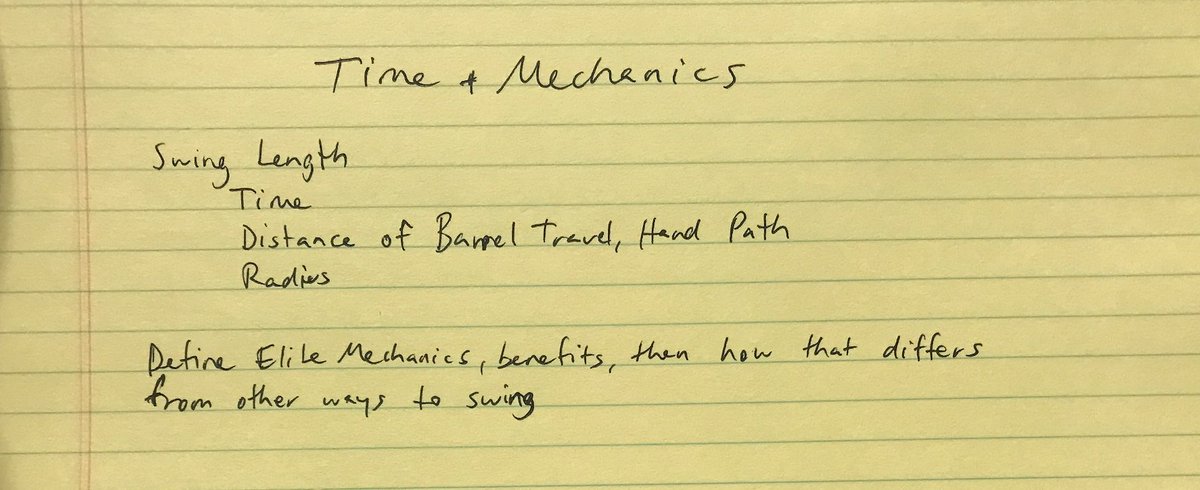More timing talk...
When considering "length of swing," there are many sub-topics to think about. Bat speed numbers, honestly, are pretty boring and don& #39;t give much context. The time to impact metrics with swing sensors rely on a velocity threshold. Is that good?
When considering "length of swing," there are many sub-topics to think about. Bat speed numbers, honestly, are pretty boring and don& #39;t give much context. The time to impact metrics with swing sensors rely on a velocity threshold. Is that good?
I consulted with @DiamondKinetics and finding better ways to measure timing was a constant topic and ask of mine. (I had a call with @CJ_Handron on Thursday to keep pushing that boundary.)
So when looking at "length" and time, what are we really trying to determine?
So when looking at "length" and time, what are we really trying to determine?
It is a very fluid topic because each pitch, each situation, each variant of the hitter& #39;s timing will create context the sensors don& #39;t know about. The hitter might do something amazing and the sensor says it sucks.
Looking at averages can be very dangerous. Doing assessments and studies without game-like context can be very dangerous.
And game-like context is pretty damn hard to replicate. Emotions, fatigue, adrenaline, soreness, low confidence from being 0-3...
And game-like context is pretty damn hard to replicate. Emotions, fatigue, adrenaline, soreness, low confidence from being 0-3...
So length...
- Having a swing that can be short or long is an advantage.
- Having a swing that is short but can& #39;t be long has holes.
- Having a swing that is long but can& #39;t be short has holes.
- Having a swing that can be short or long is an advantage.
- Having a swing that is short but can& #39;t be long has holes.
- Having a swing that is long but can& #39;t be short has holes.
Ability to adjust your arc length and width is where the swing gets adjustable. That is pulling the hands in, letting the hands out, extending as the pitch demands.
Hitting happens in winning the smallest battles where you don& #39;t let yourself roll over or miss under or over.
Hitting happens in winning the smallest battles where you don& #39;t let yourself roll over or miss under or over.
Pitchers are doing everything they can to be off by fractions of an inch. This stuff is hard. So having a swing that can react, that you can control is critically important.
The radius of the arc will sometimes be really tight, other times it will be really long.
I was taught a "knob to ball" swing that made a tight arc nearly impossible. "Rotational" hitting can sometimes cause swing arcs that stay too tight.
I was taught a "knob to ball" swing that made a tight arc nearly impossible. "Rotational" hitting can sometimes cause swing arcs that stay too tight.
When you look at different swing techniques and understand the barrel path requirements, you can start to look at the concept of swing commitment and how (and when) a hitter has to initial force/leverage to get the bat moving.
From there, different swing beliefs start to take shape. Priorities get established. And that& #39;s where most of swing debates live.
Two examples:
- Do you prioritize quickness and lose adjustability?
- Do you prioritize launch angle and lose zone length?
Two examples:
- Do you prioritize quickness and lose adjustability?
- Do you prioritize launch angle and lose zone length?
Two more:
- Does "hitting the ball deep" prevent you from catching balls out front?
- Does "hit it out front" prevent you from catching balls deep?
- Does "hitting the ball deep" prevent you from catching balls out front?
- Does "hit it out front" prevent you from catching balls deep?
Obviously you need to be quick - especially at the highest levels of the game.
Quick has a definition though. The least amount of time you have is a fastball on the inside corner and up. It is the pitch that takes the least time to arrive you& #39;ll need to hit most out front.
Quick has a definition though. The least amount of time you have is a fastball on the inside corner and up. It is the pitch that takes the least time to arrive you& #39;ll need to hit most out front.
Being on time to that pitch defines how quick you need to be, but...
When can you start moving?
When can your body start to rotate? (Very simplified wording there.)
When AND how is your barrel moving?
When can you start moving?
When can your body start to rotate? (Very simplified wording there.)
When AND how is your barrel moving?
Deeper Question: When do you become committed to the pitch and how does this coincide with pitch recognition?
All of things are related to your pre-swing rhythm, how you prepare to see the pitch and then how you get your barrel into the zone.
See the ball, hit the ball. https://abs.twimg.com/emoji/v2/... draggable="false" alt="😀" title="Grinning face" aria-label="Emoji: Grinning face">
https://abs.twimg.com/emoji/v2/... draggable="false" alt="😀" title="Grinning face" aria-label="Emoji: Grinning face">
All of things are related to your pre-swing rhythm, how you prepare to see the pitch and then how you get your barrel into the zone.
See the ball, hit the ball.

 Read on Twitter
Read on Twitter


